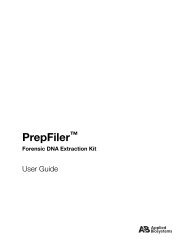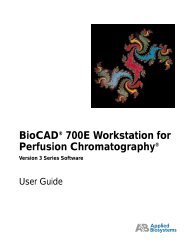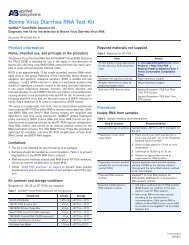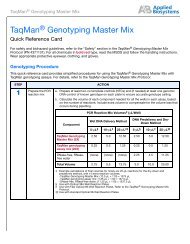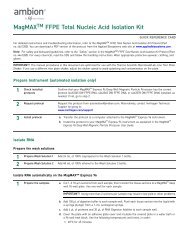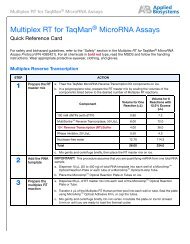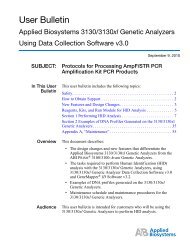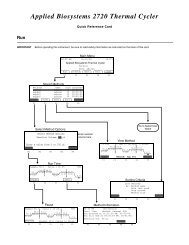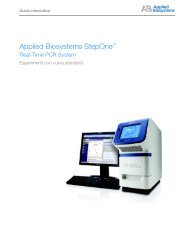AmpliTaq and AmpliTaq Gold DNA Polymerase - Applied Biosystems
AmpliTaq and AmpliTaq Gold DNA Polymerase - Applied Biosystems
AmpliTaq and AmpliTaq Gold DNA Polymerase - Applied Biosystems
You also want an ePaper? Increase the reach of your titles
YUMPU automatically turns print PDFs into web optimized ePapers that Google loves.
succinyltransferase. Antiserum from a mouse experimentally infected with live Bartonella wasreactive against recombinant SucB, indicating the mounting of an anti-SucB response followinginfection. Antigenic cross-reactivity was observed with antiserum against other Bartonella spp.Antibodies against Coxiella burnetti, Francisella tularensis, <strong>and</strong> Rickettsia typhi also reacted withour recombinant Bartonella SucB. Potential SucB antigenic cross-reactivity presents a challengeto the development of serodiagnostic tests for other intracellular pathogens that cause diseasessuch as Q fever, rickettsioses, brucelloses, tularemia, <strong>and</strong> other bartonelloses.Deng, M., T. J. Templeton, et al. (2002). "Cryptosporidium parvum Genes Containing ThrombospondinType 1 Domains." Infect. Immun. 70(12): 6987-6995.http://iai.asm.org/cgi/content/abstract/70/12/6987Cryptosporidium parvum is recognized as an enteropathogen of great worldwide medical <strong>and</strong>veterinary importance, yet underst<strong>and</strong>ing of its pathogenesis has been hampered in part bylimited knowledge of the invasion machinery of this parasite. Recently, genes containingthrombospondin type 1 (TSP1) domains have been identified in several genera of apicomplexans,including thrombospondin-related adhesive proteins (TRAPs) that have been implicated as keymolecules for parasite motility <strong>and</strong> adhesion onto host cell surfaces. Previously, a large-scaler<strong>and</strong>om survey of the C. parvum genome conducted in our laboratory revealed the presence ofmultiple genomic <strong>DNA</strong> sequences with a high degree of similarity to known apicomplexan TRAPgenes. In the present study, TBLASTN screening of available C. parvum genomic sequences byusing TSP1 domains as queries identified a total of 12 genes possessing TSP1-like domains. Allgenes have putative signal peptide sequences, one or more TSP1-like domains, plus additionalextracellular protein modules such as Kringle, epidermal growth factor, <strong>and</strong> Apple domains. Twogenes, putative paralogs CpTSP8 <strong>and</strong> CpTSP9, contain predicted introns near their aminotermini, which were verified by comparing PCR products from c<strong>DNA</strong> versus genomic <strong>DNA</strong>templates. Reverse transcription-PCR analysis of transcript levels reveals that C. parvum TSPgenes were developmentally regulated with distinct patterns of expression during in vitroinfection. TRAPC1, CpTSP3, <strong>and</strong> CpTSP11 were expressed at high levels during both early <strong>and</strong>late stages of infection, whereas CpTSP2, CpTSP5, CpTSP6, CpTSP8, <strong>and</strong> CpTSP9 weremaximally expressed during the late stages of infection. Only CpTSP4 was highly expressedsolely at an early stage of infection.Papazisi, L., S. Frasca, Jr., et al. (2002). "GapA <strong>and</strong> CrmA Coexpression Is Essential for Mycoplasmagallisepticum Cytadherence <strong>and</strong> Virulence." Infect. Immun. 70(12): 6839-6845.http://iai.asm.org/cgi/content/abstract/70/12/6839It was previously demonstrated that avirulent Mycoplasma gallisepticum strain Rhigh (passage164) is lacking three proteins that are expressed in its virulent progenitor, strain Rlow (passage15). These proteins were identified as the cytadhesin molecule GapA, the putative cytadhesinrelatedmolecule CrmA, <strong>and</strong> a component of a high-affinity transporter system, HatA.Complementation of Rhigh with wild-type gapA restored expression in the transformant (GT5) butdid not restore the cytadherence phenotype <strong>and</strong> maintained avirulence in chickens. These resultssuggested that CrmA might play an essential role in the M. gallisepticum cytadherence process.CrmA is encoded by the second gene in the gapA operon <strong>and</strong> shares significant sequencehomology to the ORF6 gene of Mycoplasma pneumoniae, which has been shown to play anaccessory role in the cytadherence process. Complementation of Rhigh with wild-type crmAresulted in the transformant (SDCA) that lacked the cytadherence <strong>and</strong> virulence phenotypecomparable to that found in Rhigh <strong>and</strong> GT5. In contrast, complementation of Rhigh with the entirewild-type gapA operon resulted in the transformant (GCA1) that restored cytadherence to the



